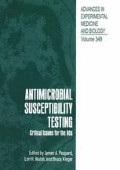Abstract
Potential Application of Probes. There are four key diagnostic applications for Nucleic Acid (N.A.) Probe Assays — they are infectious disease diagnosis, genetic disease screening, cancer diagnosis and predisposition to disease screening. Furthermore, identity testing is a non-diagnostic application of N.A. probe assays which includes two specific categories: parenteral identity testing and forensic testing.
Access this chapter
Tax calculation will be finalised at checkout
Purchases are for personal use only
Preview
Unable to display preview. Download preview PDF.
References
G.L. Archer, E. Pennell, Detection of methicillin resistance in staphylococci by using a DNA probe, Antimicrob. Agents Chemother. 34(9): 1720–1724 (1990).
F. Barany, The ligase chain reaction (LCR) in a PCR world, PCR Methods and Applications 1:5–16 (1991).
C.E. Bush, L.J. DiMichele, W.R. Peterson, D.G. Sherman, and J.H. Godsey, Solid-phase time-resolved fluorescence detection of HIV PCR amplification product, Analytical Biochemistry. 202 (1): 146–151 (1992).
C.E. Bush, K.M. Vanden Brink, D.G. Sherman, W.R. Peterson, L.A. Beninsig, and J.H. Godsey, Detection of Escherichia coli r RNA using target amplification and time-resolved fluorescence detection, Molecular and Cellular Probes. 5:1064–1079 (1991).
C.E. Bush, R.M. Donovan, W.R. Peterson, M.B. Jennings, V. Bolton, D.G. Sherman, K.M. Vanden Brink, L.A. Beninsig, J.H. Godsey, Detection of HIV-1 RNA in plasma from high risk pediatric patients using the self-sustained sequence replication reaction, J. Clin. Microbiol 30(2):281–286 (1992).
P. Coll, K. Phillips, F.C Tenover, Evaluation of a rapid method of extracting DNA from stool samples for use in hybridization assays, J. Clin. Microbiol. 27(10):2245–2248 (1989).
J. DeLey, Intra and Intergeneric Similarities of the Ribosomal RNA Cistrons of Acetobacter and Gluonobacter, Int. J. System. Bact. 30 (l):7–27 (1980).
J.C. Guatelli, K.M. Whitfield, D.Y. Kwoh, K.J. Barringer, D.D. Richman, and T.R. Gingeras, Isothermal In Vitro Amplification of Nucleic Acids by a Multienzyme Reaction Modeled After Retroviral Replication, Proc. Natl. Acad. Sci. 87:1874–1878 (1990).
S. Huovinen, M.L. Klossner, M.L. Katila, P. Houvinen, Plasmid-Mediated Beta-Lactamases among aminoglycoside resitant gram-negative bacilli, Scand. J Infect. Dis. 21 (3):303–309 (1989).
G.A. Jacoby, M.J. Blaser, P. Santanam, H. Hachler, F.H. Kayser, R.S. Hare, G.H. Miller, Appearance of Amikacin and Tobramycin Resistance Due to 4’-Aminoglycoside Nucleotidyltransferase [ANT(4’)-II] in Gram-Negative Pathogens, Antimicrob. Agents Chemother. 34(12):2381–2386 (1990).
D.Y. Kwoh, G.R. Davis, K.M. Whitfield, H.L. Chappelle, L. DiMichele, and T.R. Gingeras, Transciption-Based Amplification System and Detection of Amplified Human Immunodeficiency Cirus Type 1 with a Bead-Based Sandwich Hybridization Format, Proc. Natl. Acad. Sci. 86:1171–1177 (1989).
P.M. Lazardi, C.E. Guerra, H. Lomeli, I. Tussie-Luna, F.R. Kramer, Exponential Amplification of Recombinant-RNA Hybridization Probes, Biotechnology. 6:1197–1202 (1989).
R. Lewis, Innovative Alternatives to PCR Technology are Proliferating, The Scientist Jan. 21:23–24 (1991).
M.C Longo, M.S. Rerninger, and Hartley, Use of Uracil DNA Glycosylase to Control Carry-over Contamination in Polymerase Chain Reactions, Gene 93:125–128(1990).
K.B. Mullis, and F.A. Faloona, Specific Synthesis of DNA In Vitro Via a Polymerase-Catalyzed Chain Reaction, Methods Enzymol. 155:335–350 (1987).
H. Ounissi, E. Derlot, C. Carlier, P. Courvalin, Gene Homogeneity for Aminoglycoside-Modifying Enzymes in Gram-Positive Cocci, Antimicrob. Agents Chemother. 34(11):2164–2168 (1990).
R. Sanchez-Pescador, M.S. Stempien, and M.S. Urdea, Rapid Chemiluminescent Nucleic Acid Assays for Detection of TEM-1 Beta-Lactamase-Mediated Penicillin Resistance in Neisseria gonorrhoeae and Other Bacteria, J. Clin. Microbiol. 26:1934–1938 (1988).
F.C. Tenover, K.L. Phillips, T. Gilbert, P. Lockhart, P.J. O’Hara, J.J. Plorde, Development of a DNA Probe from the Deoxyribonucleotide Sequence of a 3-N-Aminoglycoside Acetyltransferase [AAC(3)-1] Resistance Gene, Antimicrob. Agents Chemother. 33(4):551–559 (1989).
M.S. Urdea, J.A. Running, T. Horn, J. Clyne, L. Ku, and B.D. Warner, A Novel Method for the Rapid Detection of Specific Nucleotide Sequences in Crude Biological Samples Without Blotting or Radioactivity: Application to the Analysis of Hepatitis B Virus in Human Serum, Gene 61:253–264 (1987).
M.S. Urdea, B.D. Warner, J.A. Running M. Stempien, J. Clyne, and T. Horn, A Comparison of Non-Radioisotopic Hybridization Assay Methods Using Fluorescent, Chemiluminescent and Enzyme-labeled Synthetic Oligodeoxyrobonucleotide Probes, Nucleic Acid Res. 16:4937–4956(1988).
I. Wieder, Method and Apparatus for Improved Analytical Fluorescent Spectroscopy, U.S. Patent 4,058,732 (November 15, 1977).
D.Y. Wu, and R.B. Wallace, The Ligation Amplification Reaction (LAR)-Amplification of Specific DNA Sequences Using Sequential Rounds of Template-Dependent Ligation, Genomics 4:560–569 (1989).
Author information
Authors and Affiliations
Editor information
Editors and Affiliations
Rights and permissions
Copyright information
© 1994 Springer Science+Business Media New York
About this chapter
Cite this chapter
Godsey, J.H., Vanden Brink, K.M., DiMichele, L.J., Beninsig, L.A., Peterson, W.R., Sherman, D.G. (1994). Commercialization of Nucleic Acid Probe Technology: Current Status. In: Poupard, J.A., Walsh, L.R., Kleger, B. (eds) Antimicrobial Susceptibility Testing. Advances in Experimental Medicine and Biology, vol 349. Springer, Boston, MA. https://doi.org/10.1007/978-1-4757-9206-5_11
Download citation
DOI: https://doi.org/10.1007/978-1-4757-9206-5_11
Publisher Name: Springer, Boston, MA
Print ISBN: 978-1-4757-9208-9
Online ISBN: 978-1-4757-9206-5
eBook Packages: Springer Book Archive

